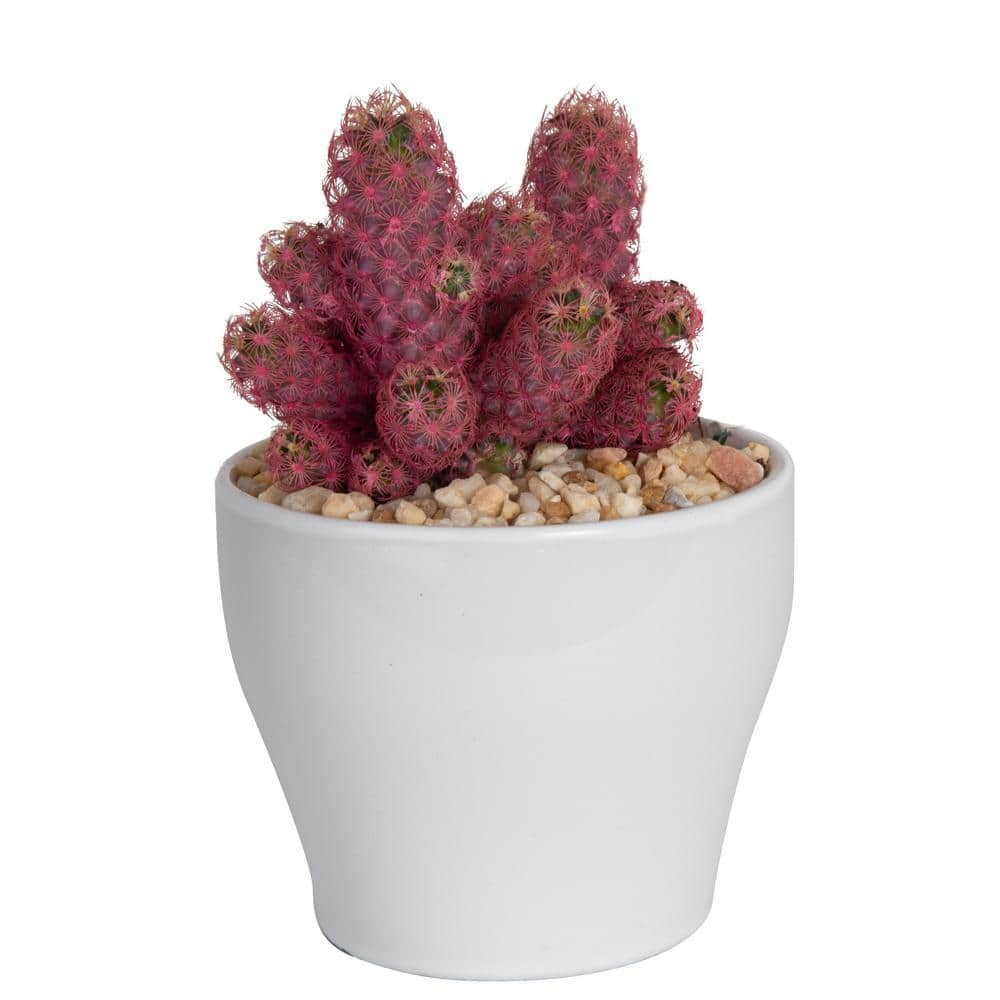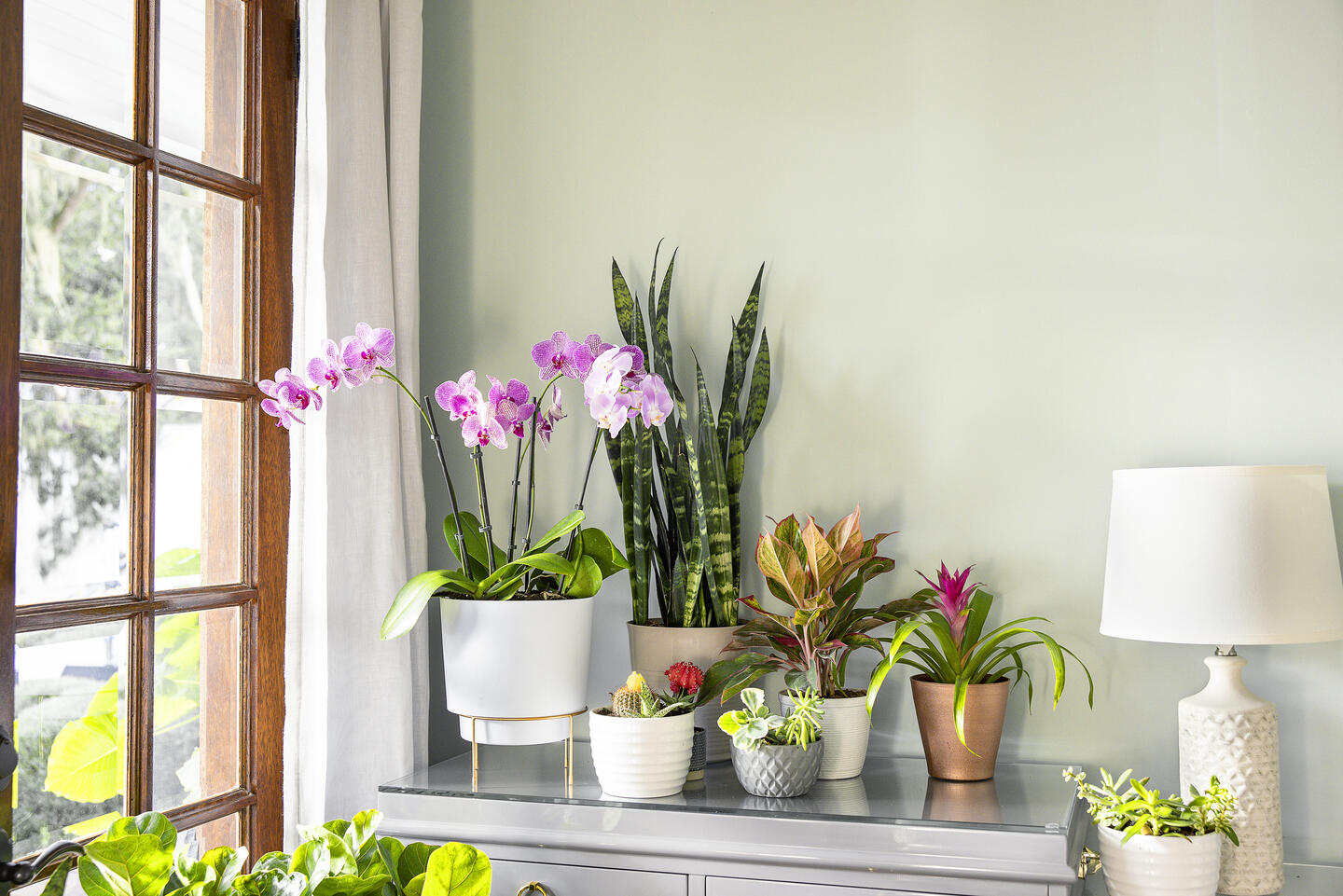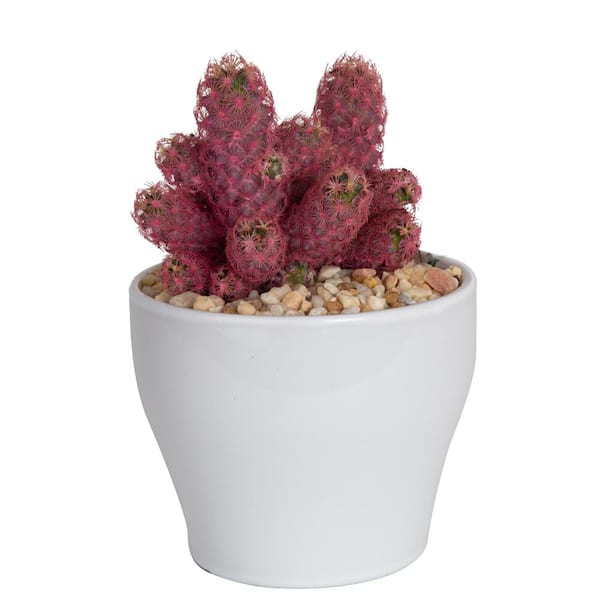Cactus in pot is a popular way to grow and display cacti, providing a convenient and decorative option for those interested in cultivating these unique plants. Cacti are fascinating plants known for their ability to thrive in arid environments.
With their spiky exteriors, cacti have become popular additions to households and gardens worldwide. The use of pots allows for easy maintenance and mobility, making cacti in pots a practical choice for both indoor and outdoor cultivation. In addition to their aesthetic appeal, cacti in pots require minimal watering and care compared to other types of houseplants.
Their fleshy stems and ability to store water make them suitable for the low-maintenance gardener or those with limited time for plant care. Whether you’re a seasoned gardener or a beginner looking to add greenery to your space, cacti in pots provide a simple and visually appealing option that can thrive in various conditions. Discover the endless possibilities of cactus varieties and their potting arrangements to create a unique and striking display.
Choosing The Right Cactus
When it comes to cactus in pots, choosing the right one is crucial. Consider factors like sunlight, watering needs, and pot size to ensure your cactus thrives in its new home.
Consider The Climate And Growing Conditions
When it comes to choosing the right cactus for your pot, it’s important to consider the climate and growing conditions. Cacti are native to arid regions, so they thrive in dry and sunny environments. Before selecting a cactus, assess your local climate and the conditions where you plan to keep the potted plant. If you live in a region with harsh winters or extreme humidity, you’ll need to choose a cactus variety that can withstand these conditions. Keep in mind that cacti require plenty of sunlight, so ensure that the spot you choose for your potted cactus receives at least 4-6 hours of direct sunlight each day.
Selecting The Right Size And Shape
The size and shape of the cactus you choose will largely depend on personal preference and the available space in your home or garden. Cacti come in a wide range of sizes, from small and compact varieties that are perfect for tabletop displays to tall and slender ones that make a statement as a focal point in your garden. Consider the location where you plan to keep the cactus and select a size that fits well in that space. Additionally, think about the shape of the cactus. Some have a round and globular form, while others have a more columnar or branching growth pattern. Choose a shape that appeals to you and complements the overall aesthetic of your home or garden design.
Research On Specific Care Requirements
To ensure the health and longevity of your cactus, it’s essential to research and understand its specific care requirements. Different cactus varieties have varying needs when it comes to watering, soil type, and fertilization. Some cacti require infrequent watering, while others need a bit more moisture. Similarly, certain cacti thrive in well-draining soil, while others prefer a slightly richer mix. By doing your homework and knowing the specific care requirements, you’ll be better equipped to provide the ideal conditions for your chosen cactus. This will help prevent common issues such as overwatering or undernourishment, which can lead to root rot and other problems. In conclusion, choosing the right cactus for your pot involves considering the climate and growing conditions, selecting the right size and shape, and researching the specific care requirements. By taking these factors into account, you can create a suitable environment for your cactus and ensure its healthy growth and longevity. Remember, each cactus is unique, so it’s important to understand its individual needs to provide the best care possible.

Credit: www.homedepot.com
Selecting The Perfect Pot
When it comes to taking care of your cactus, selecting the perfect pot is essential. The right pot not only adds to the aesthetic of your indoor or outdoor space, but it also plays a crucial role in the health and well-being of your cactus. In this article, we will explore the materials suitable for cactus pots, the importance of choosing the right size and shape, and ensuring proper drainage. Let’s dive in!
Materials Suitable For Cactus Pots
Choosing the right material for your cactus pot is crucial for its overall health and growth. Some of the suitable materials for cactus pots include:
- Terra Cotta: This classic option is highly porous, allowing for excellent drainage and air circulation, which is ideal for cacti. Plus, its natural earthy look adds a touch of elegance to any space.
- Ceramic: Ceramic pots offer both functionality and style. They come in various colors, shapes, and patterns, allowing you to find the perfect match for your cactus. Just ensure there are drainage holes at the bottom to prevent waterlogging.
- Concrete: If you’re looking for a more contemporary and durable option, concrete pots are a great choice. Like terra cotta, they also provide good drainage and breathability for your cactus.
- Plastic: While not as aesthetically pleasing as other options, plastic pots are lightweight and affordable. These pots often come with drainage holes and are easy to clean, making them a convenient choice for beginners.
Choosing The Right Size And Shape
The size and shape of the pot are important factors to consider when selecting the perfect one for your cactus. Here are some guidelines to follow:
- Size: Choose a pot that allows enough space for your cactus to grow. Typically, the diameter of the pot should be slightly larger than the cactus itself, allowing room for new growth and preventing overcrowding.
- Shape: Cacti have shallow root systems, so selecting a pot with a wide and shallow shape is ideal. This allows the roots to spread out and anchor the cactus securely.
Ensuring Proper Drainage
Proper drainage is vital for the health of your cactus. Without it, excess water can lead to root rot and other issues. Here’s how to ensure your pot has adequate drainage:
- Drainage Holes: Look for pots with drainage holes at the bottom. These holes allow excess water to escape, preventing waterlogged soil.
- Saucers: Place a saucer or tray beneath the pot to catch any water that drains out. Empty the saucer after watering to avoid water pooling around the roots.
- Soil: Using a well-draining cactus soil mix can also aid in proper drainage. Cactus soil is typically gritty and looser than regular potting soil, allowing water to flow through more easily.
By adhering to these guidelines for selecting the perfect pot, you can create the ideal environment for your cactus to thrive. Remember, the right pot not only complements your cactus visually but also provides the necessary conditions for its overall well-being.
Growing cacti in pots is a great way to add natural beauty to your home or office. Cacti are known for their unique shapes, vibrant flowers, and ability to thrive in arid conditions. To ensure their health and longevity, it is essential to provide them with optimal growing conditions. In this article, we will explore the sunlight requirements, temperature and humidity considerations, watering techniques, fertilization and soil recommendations, as well as common mistakes to avoid when growing cacti in pots.
Sunlight Requirements For Different Cacti
Cacti thrive in bright sunlight, but the intensity and duration they require depend on their species. Here are some sunlight recommendations for different types of cacti:
| Cactus Variety | Sunlight Requirements |
|---|---|
| Desert Cacti, such as the Saguaro or Barrel Cactus | They require full sun exposure for at least 6 hours a day. |
| Jungle Cacti, like the Christmas or Easter Cactus | They prefer bright, indirect sunlight, often thriving in shaded areas. |
| Epiphytic Cacti, including the Orchid Cactus or Rhipsalis | They prefer bright but filtered light, such as an eastern or western exposure. |
Temperature And Humidity Considerations
Cacti are adapted to various temperature ranges and can tolerate both extreme heat and cold. However, providing the right temperature and humidity levels will optimize their growth. Keep the following in mind:
- Cacti thrive in temperatures between 70°F (21°C) and 90°F (32°C), mimicking their natural desert habitats.
- Avoid exposing cacti to sudden temperature changes, as this can cause stress and damage their sensitive tissues.
- While most cacti prefer low humidity, jungle cacti thrive in humid environments, needing occasional misting to mimic their natural habitat.
Watering Techniques And Frequency
Proper watering is crucial for the health of your cacti in pots. Follow these techniques and frequency guidelines:
- Water cacti thoroughly but infrequently. Wait until the soil is completely dry before watering again.
- Use a well-draining cactus potting mix to prevent root rot and ensure proper water drainage.
- During the active growing season (spring and summer), water the cactus once every two weeks. Reduce watering frequency during the dormant winter months.
- Water at the base of the plant to avoid rotting the delicate cactus roots.
Fertilization And Soil Recommendations
Cacti require minimal fertilization. Follow these recommendations to keep them healthy:
- Use a balanced cactus fertilizer with low nitrogen content, applied once or twice during the growing season.
- Apply fertilizer sparingly to prevent nutrient overload, which can harm the cacti.
- Choose a well-draining soil mix specifically formulated for cacti, ensuring it is rich in organic matter and perlite.
- Repot cacti every two to three years to refresh the soil and allow for proper root growth.
Avoiding Common Mistakes
While growing cacti in pots is relatively straightforward, a few common mistakes can hinder their growth. Avoid these pitfalls:
- Overwatering: The biggest mistake is watering too frequently, which can lead to root rot.
- Using the wrong soil: Cacti need well-draining soil to prevent water stagnation and root problems.
- Placing cacti in a dark corner: Ensure they receive adequate sunlight to maintain their health and vibrant appearance.
- Overfertilizing: Too much fertilizer can burn the cacti’s sensitive roots, so adhere to the recommended guidelines.
- Not repotting when needed: As cacti grow, they may outgrow their pots, so monitor their root development and repot accordingly.
By providing the optimal growing conditions, you can enjoy the beauty of cacti in pots for years to come.
;Resize=(920,575))
Credit: www.homedepot.com
Caring For Your Cactus
Learn the essential tips for caring for your cactus in a pot. Discover the best watering techniques, ideal potting mix, and proper sunlight requirements for a healthy and thriving cactus.
Handling Cacti During Seasonal Changes
Caring for your cactus properly is essential for maintaining its health and ensuring it thrives in its pot. Pruning and grooming your cactus regularly, managing potential pests and diseases, and handling it correctly during seasonal changes are key aspects of cactus care.
Pruning And Grooming Tips
Pruning your cactus involves removing any dead or damaged parts to promote its growth and overall appearance. To do this, use a clean pair of shears or a sharp knife and cut close to the main stem. Be sure to wear protective gloves to avoid getting pricked by the cactus spines. After pruning, allow the cut ends to dry before placing the cactus back in its pot. Grooming your cactus includes removing any dust or dirt that may have accumulated on its surface. Use a soft cloth or a soft-bristled brush to gently wipe or brush away the debris. This not only keeps your cactus looking clean but also allows it to absorb sunlight more efficiently for photosynthesis.
Managing Potential Pests And Diseases
Although cacti are generally hardy plants, they are still susceptible to pests and diseases. Common pests include mealybugs, aphids, and spider mites. To manage these pests, inspect your cactus regularly and immediately treat any signs of infestation. You can use insecticidal soap or a mixture of water and dish soap to control pests. Apply the solution directly to the affected areas, making sure to cover all crevices. Diseases such as root rot and fungal infections can also affect your cactus. To prevent these issues, avoid overwatering and ensure proper drainage in the pot. If you notice any signs of disease, such as discolored or mushy spots, remove the affected parts and treat the cactus with a fungicide specifically formulated for cacti.
Handling Cacti During Seasonal Changes
Seasonal changes can affect the care needs of your cactus. During warmer months, your cactus may require more frequent watering to prevent dehydration. However, in the colder months, it is important to reduce waterings and allow the soil to dry out between waterings to prevent root rot. In addition, during the colder months, your cactus may require less sunlight. If you notice your cactus becoming pale or stretching towards the light source, it may be an indication that it is not receiving enough light. Consider moving your cactus to a brighter location or providing supplemental light using grow lights. By following these pruning and grooming tips, managing potential pests and diseases, and handling your cactus correctly during seasonal changes, you can ensure that your cactus in a pot stays healthy and thriving. Remember to always observe your cactus closely and provide the care it needs based on its individual requirements.
Decorating With Cactus
When it comes to adding a touch of uniqueness and style to your home decor, cacti in pots are a perfect choice. With their bold shapes, vibrant colors, and low-maintenance qualities, cacti make for stunning and versatile decorative elements. In this article, we will explore various ideas for decorating with cactus, covering placement and arrangement ideas, pairing cacti with complementary decor, and choosing the right pots and accessories.
Placement And Arrangement Ideas
When it comes to placing and arranging your cacti, the options are endless. Consider the following ideas:
- Creating a mini desert garden on a sunny windowsill
- Arranging a variety of cacti in a terrarium or glass display case
- Adding a touch of desert flair to your outdoor patio or garden
- Grouping different-sized cacti on a shelving unit for a dramatic effect
Pairing Cacti With Complementary Decor
Pairing your cacti with complementary decor can enhance their visual appeal and create a cohesive look in your space. Consider incorporating the following elements:
- Geometric patterns in cushions, rugs, or artwork to accentuate the angular shapes of cacti
- Succulent plants and other desert-inspired foliage to create a desert oasis in your home
- Natural materials like woven baskets or wooden plant stands to add texture
- Minimalistic and modern furniture to create a clean and contemporary look
Choosing The Right Pots And Accessories
Choosing the right pots and accessories is crucial to showcase your cacti in style. Consider the following factors:
| Pot Size | Style | Drainage |
|---|---|---|
| Opt for pots that are slightly larger than the cactus root ball, allowing room for growth. | Choose pots with simple designs or textured finishes that complement the aesthetics of your space. | Ensure that the chosen pot has drainage holes to prevent waterlogging and maintain healthy root growth. |
Additionally, consider accessorizing your cacti with:
- Pebbles: Place pebbles on top of the soil to create a visually appealing landscape.
- Moss: Add moss around the base of your cacti to create a natural woodland feel.
- Miniature figurines: Incorporate miniature figurines, such as tiny animals or buildings, to create whimsical scenes.
By considering these placement and arrangement ideas, pairing your cacti with complementary decor, and choosing the right pots and accessories, you can transform your space into a desert-inspired haven filled with the beauty of cacti.

Credit: www.homedepot.com
Frequently Asked Questions For Cactus In Pot
Can Cactus Be Grown In A Pot Indoors?
Yes, cacti can thrive in a pot indoors. They are perfect houseplants because they require minimal care and can tolerate low light and dry conditions. Just ensure the pot has good drainage and use a cactus-specific potting mix.
How Often Should I Water My Potted Cactus?
Cacti are desert plants, so they have the ability to store water in their tissues. It’s best to underwater rather than overwater them. Wait until the soil is completely dry before watering, which could be every 1-2 weeks depending on the environment and season.
What Type Of Soil Is Best For Potted Cacti?
Cacti need well-draining soil to prevent roots from rotting. A cactus-specific potting mix is ideal, which contains a blend of sand, perlite, and soil. It promotes excellent drainage, preventing waterlogged soil that can harm the cactus.
How Much Sunlight Does A Potted Cactus Need?
Most cacti require direct sunlight for at least 6 hours a day. Place your potted cactus near a sunny window or outdoors on a sunny patio. Be cautious of intense afternoon sun, as it can scorch the cactus. Find a balance between sunlight and shade for optimal growth.
Conclusion
The cactus in a pot is a low-maintenance plant that adds beauty and personality to any space. With their unique shapes and vibrant colors, cacti can thrive in various environments. Whether you’re a beginner or experienced gardener, these resilient plants are a great addition to your indoor or outdoor collection.
Remember to provide the right conditions, such as well-draining soil and proper sunlight, and enjoy the beauty and benefits that cacti bring.
